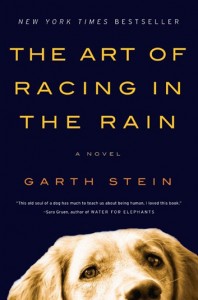
College students rarely get the opportunity to read a book not required for class, so the easy to read, relatively short novel “The Art of Racing in the Rain” is the good way to break from textbook monotony and enjoy a reading experience.
“The Art of Racing in the Rain” is an insightful, creative and inspiring story that will keep readers pulling it off the shelf to read and reread for years to come.
Though this is not a new novel, it was on the New York Times Bestseller list for more than 40 weeks after it was first published in 2008 and is one of those books that doesn’t lose its relevance or appeal with time.
“The Art of Racing in the Rain” is a fictional novel written from the perspective of a racecar enthused dog, Enzo, who believes the Mongolian legend that when a dog is “finished living his lifetimes as a dog,” he will be reincarnated as a human after watching a documentary on the subject.
Enzo spends most of his days watching TV as his master, Denny, works at an auto repair shop. The dog pays attention to the programming and hence learns a lot about human life.
Though he is a golden retriever, Enzo has always felt human because, unlike most other dogs, he pays attention to the world around him and learns from it.
Because of this, he plans to have Denny put him down—after aging and living in arthritic pain—so that he can begin his new life as a human and relieve his master of all the financial burden of caring for an old dog.
The author, Garth Stein, does a superb job capturing the essence of the canine’s thoughts and actions while developing the other characters.
Supporting characters, like Denny, Denny’s in-laws and other people that surround the dog, are described and established solely through Enzo’s observations and thoughts.
While it would be easy to jumble things up when a novel is only written from an omniscient perspective, Stein keeps the story line clean and enjoyable.
Enzo explains to the reader why he ready to become a human in his next life through a series of chronological flashbacks that walk the audience through the hardships Denny and his family had to endure.
Stein tackles many issues in “The Art of Racing in the Rain,” including death, being wrongfully accused of a crime, custody battles and financial problems, but does not overwhelm the audience.
All of these issues are related to each other and mirror the domino effect that often happens in life.
It’s true that a vast majority of the book is walking thorough the unfortunate and emotionally draining events of Denny’s life, which can sometimes be daunting and discouraging to the reader, but essentially make the ending that much sweeter.
Because Denny doesn’t deserve the pain he suffers, it can be aggravating to the reader that the story’s resolution is so slow coming.
However, Stein does this to make his point that persevering and keeping a positive outlook through even the most difficult times in one’s life will aid in overcoming all obstacles.
The novel asserts that life is not always fair, but the best way to make it through anything is to just believe in yourself and face problems head-on.
The author, as the title implies, is constantly relating the issues in Denny’s life to strategies of car racing. While the references increase the masculinity of the novel, widening the target audience, they are sometimes a stretch and seem almost forced into the story line.
Generally, the racing references were meant to be an escape for Enzo—something to aid him in understanding the burdens of being human—and while they are for the most part simplified for the non-racing or car enthused reader, they can also distract from the main plot line.
That being said, the story is inspiring and insightful because the reader feels like they have a lot to learn about life from a dog.
Stein gets to the core of human nature and presents it as an outside view, giving the reader a new way to think about life.
“The Art of Racing in the Rain” is an eye-opener and heart-wrencher that will keep audiences captivated long after the last page is finished.







